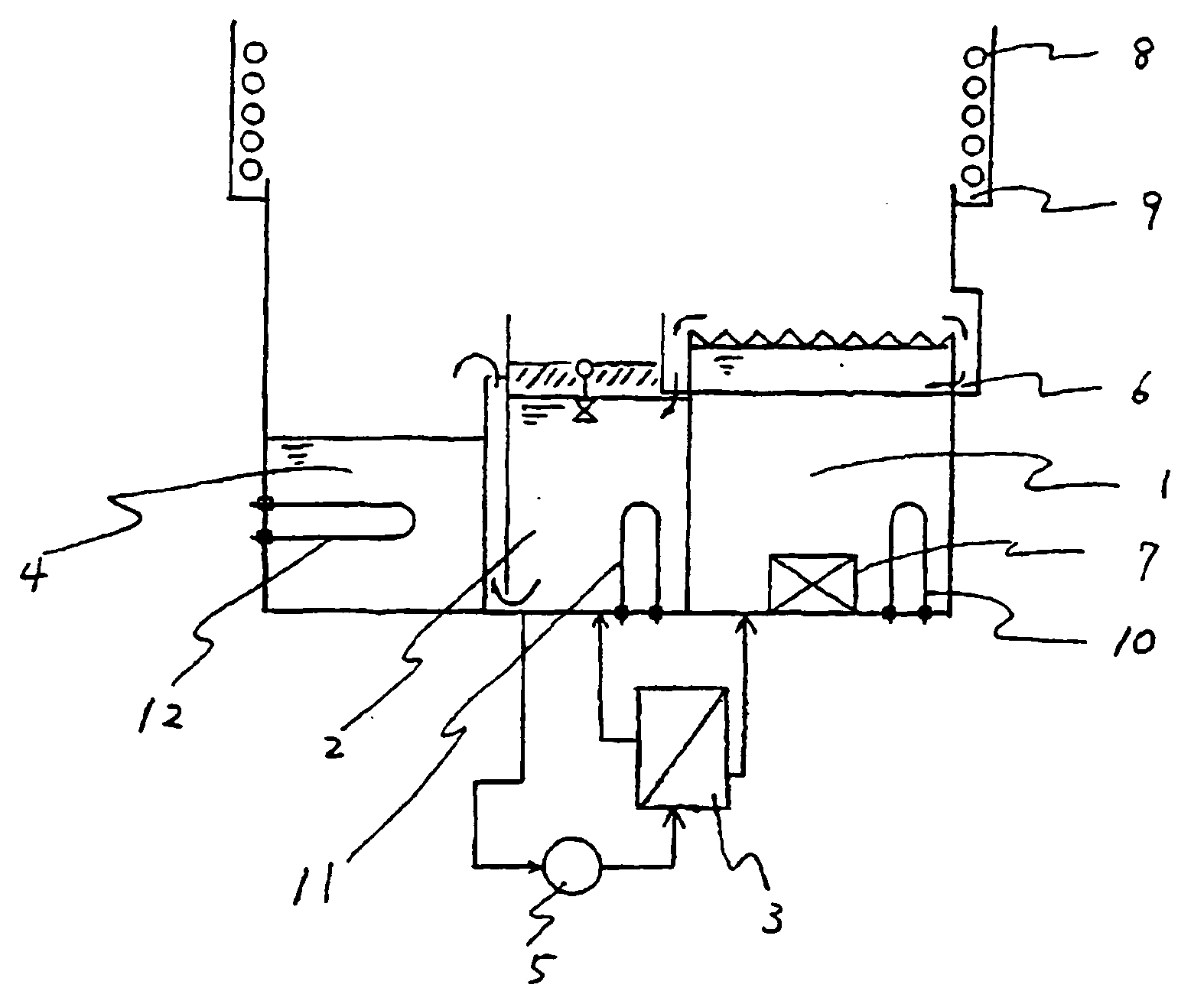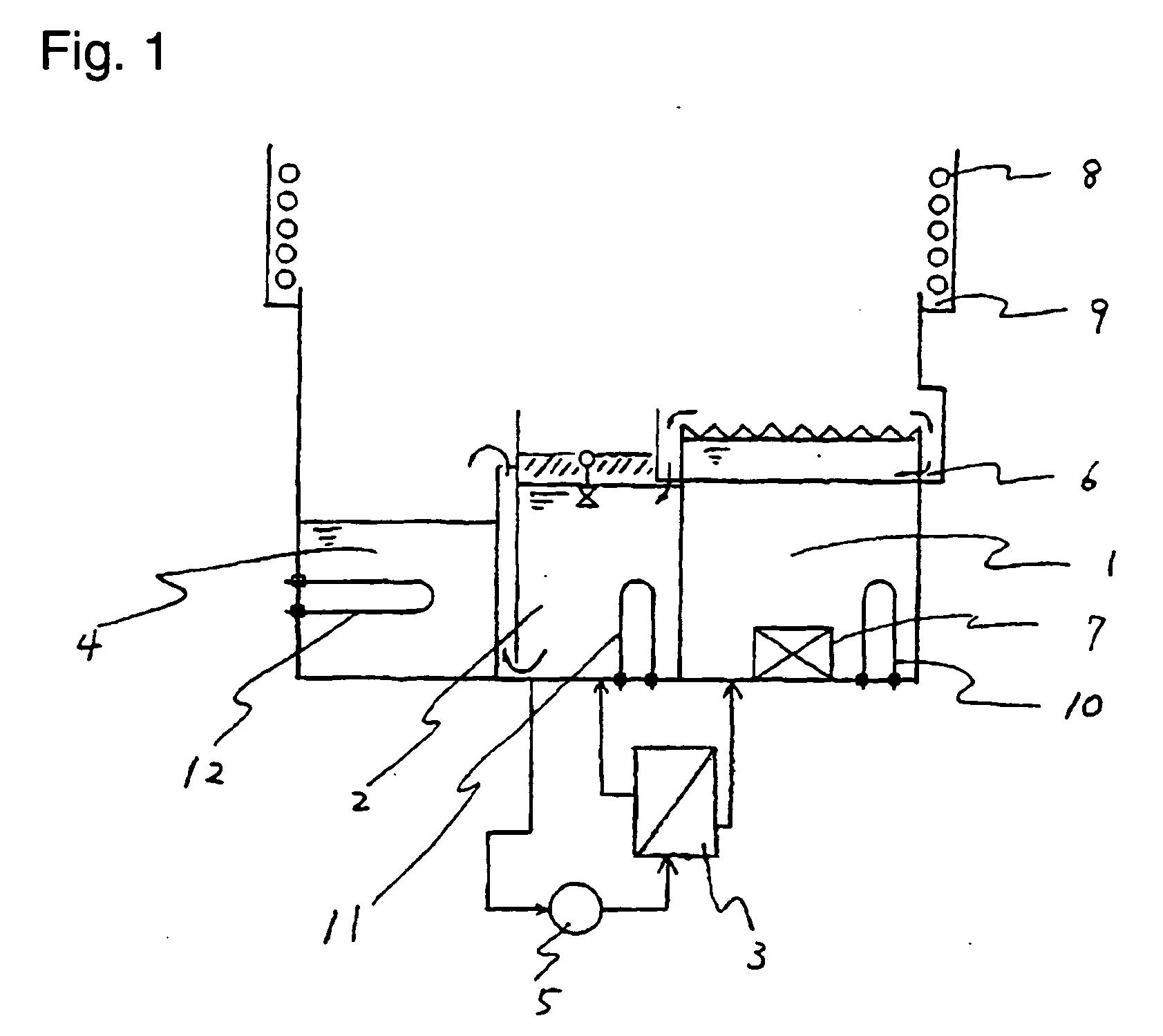Process for removing water and apparatus for removing water
- Summary
- Abstract
- Description
- Claims
- Application Information
AI Technical Summary
Benefits of technology
Problems solved by technology
Method used
Image
Examples
example 1
[0068] As articles having water attached on their surfaces, five glass plates of 50 mm×50 mm×5 mm set up in a stainless steel basket, dipped in pure water and then withdrawn, were used. As the solvent composition, a solvent mixture (boiling point: 55° C., hereinafter referred to as solvent mixture A) comprising 95.6 mass % of 1,3-dichloro-1,1,2,2,3-pentafluoropropane and 4.4 mass % of ethanol, was used, and cleaning of the glass plates to remove water was carried out 48 times at a rate of once for every 10 minutes (total: 8 hours) under the following conditions:
[0069] Temperature of solvent mixture A in dipping tank 1: [0070] 46 to 51° C.
[0071] Use of ultrasonic vibrator 7 in dipping tank 1: [0072] Yes
[0073] Dipping time of articles in dipping tank 1: [0074] 2 Minutes
[0075] Temperature of solvent mixture A in specific gravity separation tank 2: 46 to 51° C.
[0076] Exposure to vapor: 1 Minute
[0077] The glass plates subjected to final cleaning to remove water were dried immediate...
example 2
[0078] As articles having water attached on their surfaces, ten brass plates of 25 mm×30 mm×2 mm set up in a stainless steel basket, dipped in pure water and then withdrawn, were used. As the solvent composition, a solvent mixture (boiling point: 52° C., hereinafter referred to as solvent mixture B) comprising 41.1 mass % of 3,3-dichloro-1,1,1,2,2-pentafluoropropane, 54.4 mass % of 1,3-dichloro-1,1,2,2,3-pentafluoropropane and 4.5 mass % of ethanol, was used, and cleaning of the brass plates to remove water was carried out 48 times at a rate of once for every 10 minutes (total: 8 hours) under the following conditions:
[0079] Temperature of solvent mixture B in dipping tank 1: [0080] 45° C.
[0081] Use of ultrasonic vibrator 7 in dipping tank 1: [0082] Yes
[0083] Dipping time of articles in dipping tank 1: [0084] 2 Minutes
[0085] Temperature of solvent mixture B in specific gravity separation tank 2: 45° C.
[0086] Exposure to vapor: 2 Minutes
[0087] The brass plates subjected to the f...
example 3
[0088] As articles having water attached on their surfaces, five acrylic resin plates of 50 mm×50 mm×5 mm set up in a stainless steel basket, dipped in pure water and then withdrawn, were used. As the solvent composition, a solvent mixture (boiling point: 52° C., hereinafter referred to as solvent mixture C) comprising 97 mass % of 1,1,1,2,2,3,4,5,5,5-decafluoropentane and 3 mass % of 2-propanol, was used, and cleaning of the acrylic resin plates was carried out 48 times at a rate of once for every 10 minutes (total: 8 hours) under the following conditions:
[0089] Temperature of solvent mixture C in dipping tank 1: [0090] 45° C.
[0091] Use of ultrasonic vibrator 7 in dipping tank 1: [0092] No
[0093] Dipping time of articles in dipping tank 1: [0094] 2 Minutes
[0095] Temperature of solvent mixture C in specific gravity separation tank 2: 45° C.
[0096] Exposure to vapor: 1 Minute
[0097] The acrylic resin plates subjected to final cleaning to remove water were dried immediately after b...
PUM
| Property | Measurement | Unit |
|---|---|---|
| Boiling point | aaaaa | aaaaa |
| Boiling point | aaaaa | aaaaa |
| Boiling point | aaaaa | aaaaa |
Abstract
Description
Claims
Application Information
 Login to View More
Login to View More - R&D
- Intellectual Property
- Life Sciences
- Materials
- Tech Scout
- Unparalleled Data Quality
- Higher Quality Content
- 60% Fewer Hallucinations
Browse by: Latest US Patents, China's latest patents, Technical Efficacy Thesaurus, Application Domain, Technology Topic, Popular Technical Reports.
© 2025 PatSnap. All rights reserved.Legal|Privacy policy|Modern Slavery Act Transparency Statement|Sitemap|About US| Contact US: help@patsnap.com


